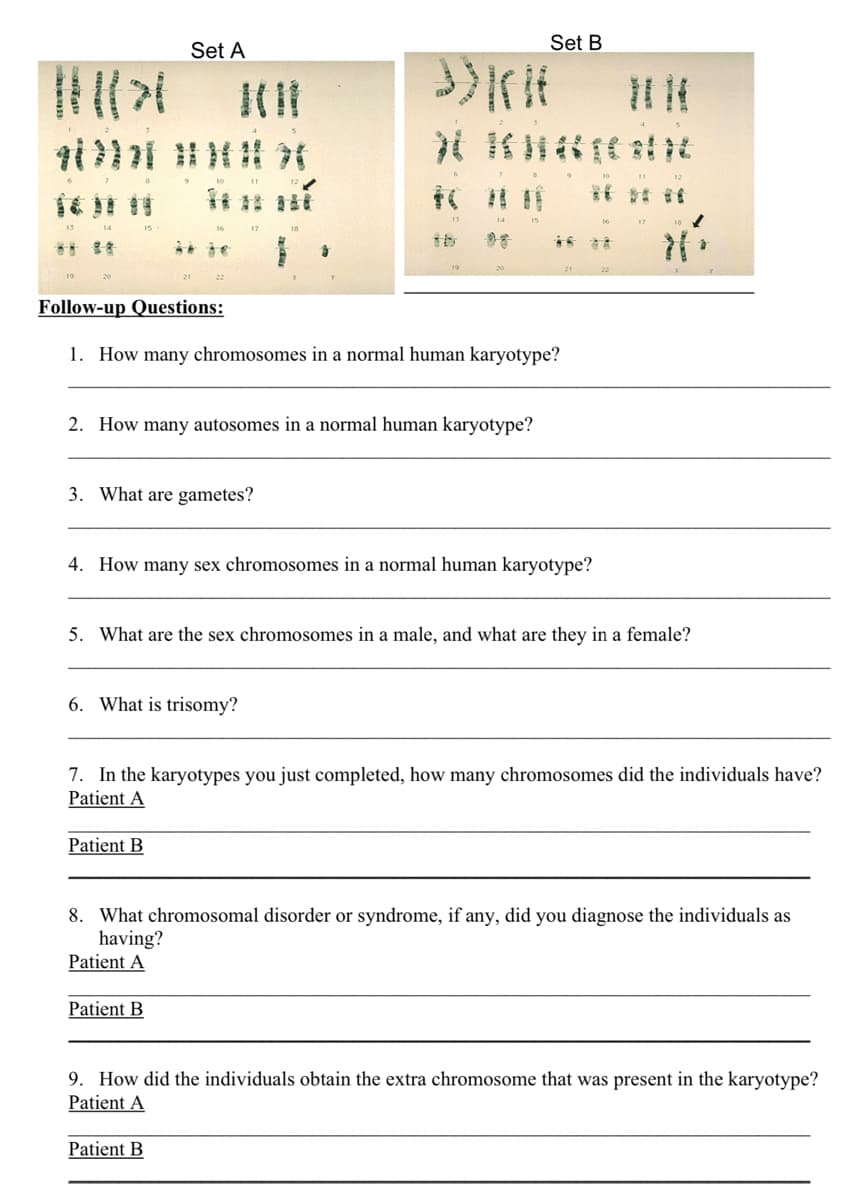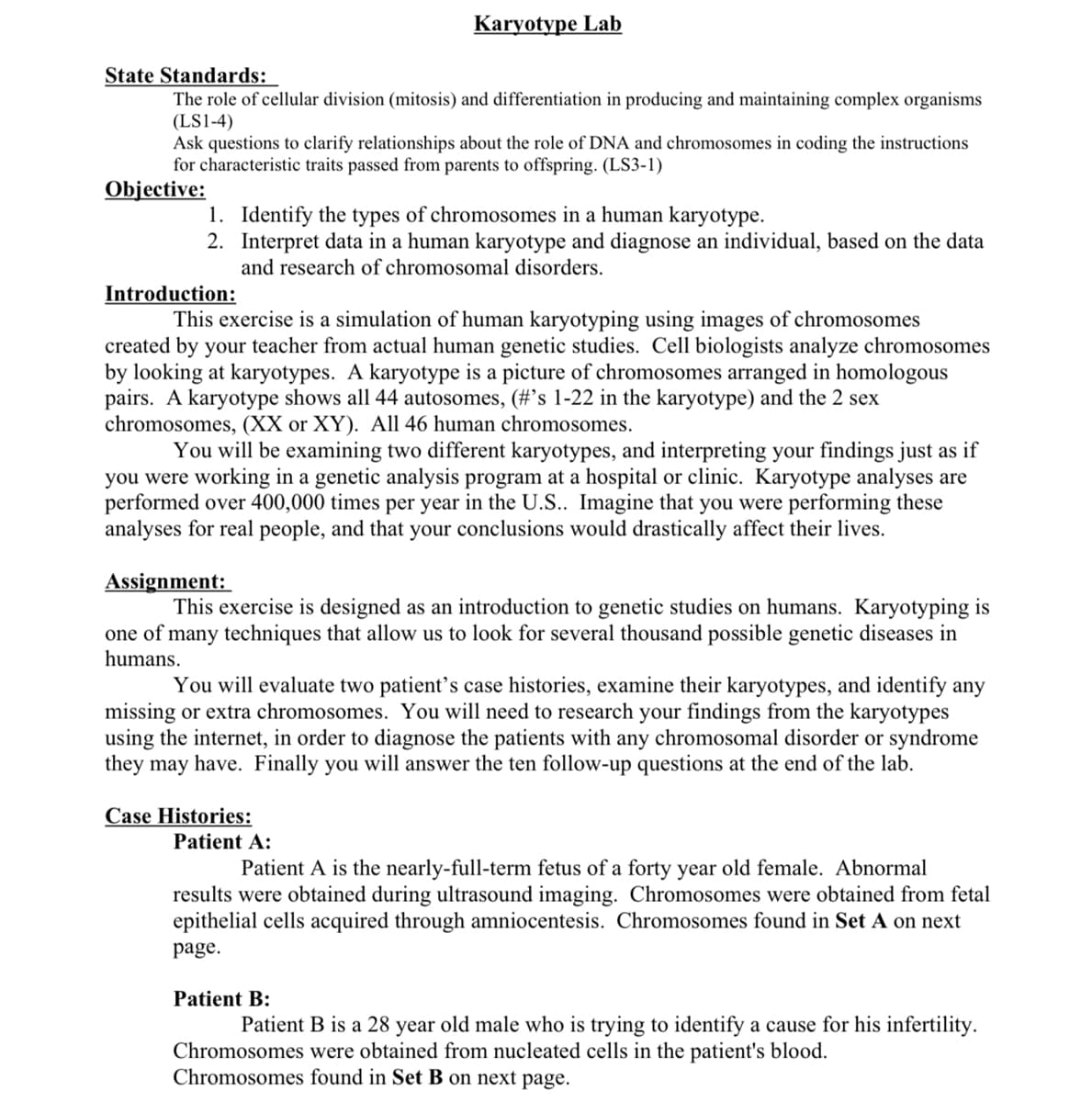Human Heredity: Principles and Issues (MindTap Course List)
11th Edition
ISBN:9781305251052
Author:Michael Cummings
Publisher:Michael Cummings
Chapter1: A Perspective On Human Genetics
Section: Chapter Questions
Problem 1CS: Mary and Marcie. identical twins, go to the same internist who is also a faculty member at a major...
Related questions
Topic Video
Question
100%

Transcribed Image Text:Set A
Set B
i》}| 汁
清 t
13
...
Follow-up Questions:
1. How many chromosomes in a normal human karyotype?
2. How many autosomes in a normal human karyotype?
3. What are gametes?
4. How many sex chromosomes in a normal human karyotype?
5. What are the sex chromosomes in a male, and what are they in a female?
6. What is trisomy?
7. In the karyotypes you just completed, how many chromosomes did the individuals have?
Patient A
Patient B
8. What chromosomal disorder or syndrome, if any, did you diagnose the individuals as
having?
Patient A
Patient B
9. How did the individuals obtain the extra chromosome that was present in the karyotype?
Patient A
Patient B

Transcribed Image Text:Karyotype Lab
State Standards:
The role of cellular division (mitosis) and differentiation in producing and maintaining complex organisms
(LS1-4)
Ask questions to clarify relationships about the role of DNA and chromosomes in coding the instructions
for characteristic traits passed from parents to offspring. (LS3-1)
Objective:
1. Identify the types of chromosomes in a human karyotype.
2. Interpret data in a human karyotype and diagnose an individual, based on the data
and research of chromosomal disorders.
Introduction:
This exercise is a simulation of human karyotyping using images of chromosomes
created by your teacher from actual human genetic studies. Cell biologists analyze chromosomes
by looking at karyotypes. A karyotype is a picture of chromosomes arranged in homologous
pairs. A karyotype shows all 44 autosomes, (#'s 1-22 in the karyotype) and the 2 sex
chromosomes, (XX or XY). All 46 human chromosomes.
You will be examining two different karyotypes, and interpreting your findings just as if
you were working in a genetic analysis program at a hospital or clinic. Karyotype analyses are
performed over 400,000 times per year in the U.S.. Imagine that you were performing these
analyses for real people, and that your conclusions would drastically affect their lives.
Assignment:
This exercise is designed as an introduction to genetic studies on humans. Karyotyping is
one of many techniques that allow us to look for several thousand possible genetic diseases in
humans.
You will evaluate two patient's case histories, examine their karyotypes, and identify any
missing or extra chromosomes. You will need to research your findings from the karyotypes
using the internet, in order to diagnose the patients with any chromosomal disorder or syndrome
they may have. Finally you will answer the ten follow-up questions at the end of the lab.
Case Histories:
Patient A:
Patient A is the nearly-full-term fetus of a forty year old female. Abnormal
results were obtained during ultrasound imaging. Chromosomes were obtained from fetal
epithelial cells acquired through amniocentesis. Chromosomes found in Set A on next
page.
Patient B:
Patient B is a 28 year old male who is trying to identify a cause for his infertility.
Chromosomes were obtained from nucleated cells in the patient's blood.
Chromosomes found in Set B on next page.
Expert Solution
This question has been solved!
Explore an expertly crafted, step-by-step solution for a thorough understanding of key concepts.
Step by step
Solved in 2 steps

Knowledge Booster
Learn more about
Need a deep-dive on the concept behind this application? Look no further. Learn more about this topic, biology and related others by exploring similar questions and additional content below.Recommended textbooks for you

Human Heredity: Principles and Issues (MindTap Co…
Biology
ISBN:
9781305251052
Author:
Michael Cummings
Publisher:
Cengage Learning

Human Heredity: Principles and Issues (MindTap Co…
Biology
ISBN:
9781305251052
Author:
Michael Cummings
Publisher:
Cengage Learning